
If you’ve been in PPC for very long, odds are, you’ve heard of google ads quality score.
There are some people who think it’s the most important thing in the account, and there are other people who pay very little attention to it.
It doesn’t matter which camp you’re in, it is important for you to know what quality score does and how it impacts your campaigns.
So in this post, I’m going to give a high-level overview of what quality score is, how you can see the different factors that go into what your quality score is, and how you can start making some adjustments to improve it.
I will start by giving the definition of quality score according to google.
What Is Quality Score?
A quality score is an estimate of the quality of your ads, keywords, and landing pages. Higher quality ads can lead to lower prices and better ad positions.
What google is trying to do is make sure that advertisers are creating a good user experience for their end-users who are also google’s end users.
Both advertisers and Google are trying to make a positive impact on anybody conducting a search.
Without those people searching, there’s no need for advertisers to be doing search advertising and there’s no need for Google to provide a search engine for advertisers to advertise on.
So, their experience is a very important factor in making sure that this entire ecosystem works. And quality score is the forward-facing kind of advertiser-friendly version of how we’re ranking according to some of google’s expectations.
What Are The Google Ad Quality Score Factors
Google ad quality score factors are reported on a 1 to10 scale and include expected click-through rate, ad relevance, and landing page experience.
Those are three of the factors that are going into quality score and we’ll talk about each of those here in just a little bit.
The biggest takeaway is that the more relevant your ads and landing pages are to the user, the more likely it is that you’ll see higher quality scores.
Again, as long as you can continue to be relevant on a topic and provide a good experience for the user, google wants to reward that because it’s in their best interest to do so.
Quality score, on the other hand, is an aggregated estimate of your overall performance in ad auctions, and is not used at auction time to determine ad rank.
This is getting a little bit more in the weeds and I’m not going to spend too much time on it but this is something that I think people get a little bit confused by so, I want to take a little bit of time to clarify.
If you look at the image below, You will see that it says the one to ten quality score shown in your account is an aggregated estimate of your overall performance in ad auctions.
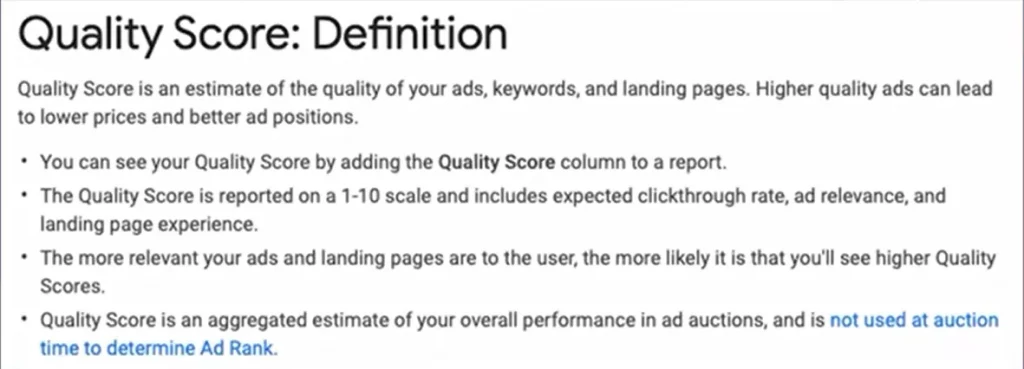
Therefore, it can’t be used at auction time to determine Ad rank. Real-time auction, specific quality calculations of expected click-through rate, ad relevance, and landing page experience.
There are also other factors that are used in calculating ad rank at auction time.
Taking a step back, what this entire section is trying to tell us is that google needs to simplify quality score to be able to share with advertisers.
Every time your ad goes into the auction, a new quality score is put together based on all these different factors that google is talking about.
It’s going to take into account your expected click-through rate, ad relevance, and landing page experience. But it’s also factoring in different layers that advertisers can’t see.
It’s thinking about what types of audiences that user is in, what their past behavior has been, and where are they in the world.
What device category are they on? How do they normally engage?
There are a lot of different factors that go into it so, every single time your ad is eligible for auction, a new quality score is going to be calculated.
Now, that might not seem like a lot, it might seem like they should be able to give you that data on a real-time basis.
Think about the number of impressions you get per day on any eligible keyword. Let’s say you get 100 impressions per day; that might not be a lot, but also factors in your impression share.
If you’re only getting a 10% impression share, then there are technically 1 000 times you were entered into the auction, and you only just showed up for 100 of them.
In every single one of those thousand instances, you were given a new quality score. That is just unmanageable information, and we’re only talking about one keyword with 100 impressions per day.
Think about really large accounts. The quality score numbers would just be fluctuating all day and it would never actually stop.
So google uses quality score in a way to aggregate that data, to make it user-friendly so advertisers can see where they stand on any given day, and make sure that they’re able to impact their ads moving forward.
Google Ads Quality Score Components Explained
I’ve already mentioned the three ad components or factors that google calls out specifically, but let’s go through each of those a little bit more in detail. The first is:
Ad relevance: This estimates the relevance, quantity, and diversity of your ad content.
So what this is trying to say is that google wants your ads to be relevant to the searches,
the queries coming through your keywords, but it also doesn’t want you to just keyword
stuff.
That’s where this quantity and diversity of your ad content comes in; because in
some instances, that Ad is not going to provide a lot of content because you’re just trying
to put in key phrases. It’s just as if you were going to do that for SEO.
The next component or factor is:
Expected click-through rate: How likely is it that your ads will get clicked when shown for that keyword regardless of your ads position, extensions, or other formats that may impact the visibility of your ads?
What google is trying to do right here is to come up with a predicted click-through rate based on how your ad should be clicked on regardless of the ad position or any of your ad extensions, anything like that.
How frequently will your Ad be clicked on each time it enters the auction.
Now, there are a few different factors that go into this. Google does look at your individual Ad account’s performance in the past.
They look at the keyword’s performance on that particular search query in order to be able to come up with this expected CTR, but it also takes into account everybody else’s Ad account that has been bidding on the keyword as well.
So, depending on how they have done, you’re going to be stacked up against how well your competition has been able to generate clicks on these queries as well.
The best example I can come up with here to illustrate the very big gap between how just you versus your competition can have an impact on queries, is going to be bidding on branded keywords and competition keywords.
If you’re bidding on your own branded keywords in your account, odds are, you’ll have a very high click-through rate because you are the brand the person is searching for.
So, typically, you’re going to have a high score when it comes to expected click-through rate.
On the flip side, if you were to bid on your competitor’s keywords, you’re probably going to have a much lower click-through rate because you’re not the brand that that person searched for.
And the expected click-through rate that google has come up with includes their account performance where they’re probably seeing those high 20 to 30 percent click-through rates on those keywords, and you just simply can’t compete with that.
So, almost invariably in brand campaigns and competitor campaigns, you’ll see a relatively high expected click-through rate and quality scores for a specific brand, but you’ll see pretty low CTR and quality score when it comes to a competition type of campaign where you’re bidding on your competitor’s keywords.
Overall, the main takeaway here is that Google is trying to give you some sort of indicator as to what they expect your click-through rate to be, and you want to make sure that you are at least hitting that benchmark, if not exceeding it, to make sure that you have a high expected click-through rate and quality score.
The last component is on:
Landing page relevance: This is an estimate of how relevant and useful your website’s landing page will be to people who click on your ad.
Again, for both advertisers and google, it’s in their best interest to make sure that whoever comes to their landing page has a good experience.
There are a number of factors that Google looks at for your landing page relevance, but I think one misconception is that people assume that google is going to adopt its SEO technology to review landing pages, with the same nitty-gritty in-depth look that it does for regular organic listings, and that’s just not the case.
They’re not looking quite as much of your keyword density, and a lot of other SEO factors that I don’t even know what they are. They’re more looking at a very high quick level of how your landing page ties into that specific user’s journey.
The factors that google is going to look at to come up with landing page relevance are pretty high level.
It’s going to make sure that the content is relevant so, yes; it is going to try and make sure that there are some keywords throughout that make sure that they tie back into the user’s search intent, as well as some surrounding phrases.
But it’s kind of just a check box to make sure that it’s on topic rather than making sure that it’s got the highest level of relevancy it possibly can.
It’s also going to look at user experience, and this is not going to nitpick based on how your landing page is put together.
You’re not going to get extra points for having a one-page form versus a two-page form or being able to buy now on the page as opposed to going through a whole cart process, it’s not looking at those types of things.
It’s more about just trying to make sure that your website from a coding perspective, is easily readable from the user experience on the other end.
Is it full of a ton of huge flash images that are just not conducive to getting information quickly? or is it pages and pages of just highly dense text?
Or is it something that’s laid out in such a way that a user could probably read it pretty quickly and get the information that they need?
The last component of your landing page experience score is going to be based on how users engage with your landing page.
If they conduct a google search, go to your landing page, and then immediately click back to the search results page, that’s going to have a negative impact on your landing page experience score.
Google is going to interpret that in one of two ways.
Either first, the content on your landing page is not relevant and the user clicked through, saw the landing page, realized it wasn’t what they wanted, and immediately bounced back to find something else.
Or it’s going to be something where the user clicked on your ad, the page simply wasn’t loading quick enough, they got impatient and went right back to the search results page.
Either way, that’s a negative factor for google. It’s a huge red flag if your landing page is not delivering the experience that their end-user wants because they went right back to the results page to try and get something else.
So, whether it’s based on user experience, the content available, page speed, or any of those factors, make sure that when users come to your page, they at least spend a little bit of time on it and try to engage with it rather than bouncing right back to the search results page; even if they don’t convert.
Frequently Asked Questions
Google ad quality score not showing
The main reason why your google ads quality score might not be showing is because your keywords lack enough exact match impressions.
Consequently, keywords need recent exact match impressions to maintain a Quality Score and may turn back to null when there isn’t enough recent traffic.
Google only calculates quality score on the exact match traffic for broad keywords. It was a change that seemed to roll out a few years back around November.
What Is Good Google Quality Score?
A good google quality score ranges from 8 to 10 when you’re working with branded keywords.
A score of 7 to 9 is good for commercial keywords. You can see a better score when you target your audience correctly and write Ads of high quality that are also unique.
How Is Google Ad Quality Score Calculated
Google ad quality score is calculated based on the performance of 3 factors which are:
- Expected clickthrough rate (CTR): The likelihood that your ad will be clicked when shown.
- Ad relevance: How closely your ad matches the intent behind a user’s search.
- Landing page experience: How relevant and useful your landing page is to people who click your ad.
Each component is evaluated with a status of “Above average,” “Average,” or “Below average.” This evaluation is based on a comparison with other advertisers whose ads showed for the exact same keyword, over the last 90 days.
If one of these components has a status of “Average” or “Below average,” this may indicate an opportunity to make improvements.
Naturally, there is a standby “1” quality score added to every quality score. This figure does not change as it is regarded as the basic quality score. So, when calculating your quality score you want to make sure to include 1. Just see it as a bonus.
Another thing to keep in mind is that the Quality Score is determined by adding up the values of the factors. For example: our keywords are: “THE BEST WEIGHTLOSS PRODUCT” and “FLAT TUMMY HERBS”
- If Expected click through rate (ECTR) of FLAT TUMMY HERBS = 0(below average)
Ad relevance of FLAT TUMMY HERBS = 1(average)
Landing page experience of FLAT TUMMY HERBS = 3.5(above average)
TOTAL = ECTR= 0 , AD RELEVANCE=1 , LANDING PAGE EXPERIENCE= 3.5 BASIC QUALITY SCORE= 1
TOTA QUALITY SCORE = 5.5 APROXMATELY = 6
2. If expected clickthrough rate (CTR) of THE BEST WEIGHTLOSS PRODUCT= 1(average)
Ad relevance of THE BEST WEIGHTLOSS PRODUCT= 2.5 (above average)
Landing page experience of THE BEST WEIGHTLOSS PRODUCT= 3.5 (above average)
TOTAL = ECTR= 1 , AD RELEVANCE=2.5 , LANDING PAGE EXPERIENCE= 3.5 BASIC QUALITY SCORE= 1
TOTA QUALITY SCORE = 8
BELOW IS THE GRAPHICAL REPRESENTATION

How Important Is Quality Score In Google Ads?
Very important
Why Is Quality Score Important?
Quality score is important as it helps to determine your ad position and CPC
What Affects Quality Score Google Ads?
Not adhering to the rules of the components of quality score, affects quality score
Benefit Of Improving Google Ads Quality Score
The benefit of improving your Ads quality score is that you will have a better Ad position and a low CPC.
How Do I Improve My Google Ad Quality Score
You can improve your google ads quality score by working on these three components of quality score which are:
Expected clickthrough rate: the more likely people are to click on your ad, the better for you as an advertiser. So, you want to make sure to use keywords that address the pain point of users. Tweaking your keywords to best match users’ searches is paramount.
Ad relevance: Your Ads should match what people are searching for, otherwise, google will see your ad as irrelevant.
If you sell phones, and you are running an ad for iPhones, make sure the title of your ad contains iPhone and the particular version.
You don’t want users to be searching for a different version and your ad will be appearing for another version. So, to users, your ads will look irrelevant
Landing page experience: The same thing applies here, your landing page should entail what you are promoting. You don’t want to have an entirely different thing on your landing page.
If you sell phones, and you are running an ad for iphone, make sure the landing page does not contain nokia phone, you want to make sure to have only iphones displayed on the landing page.
What Are The 3 Key Components of Google Ad Quality Score
The three key components of google ads quality score are:
- Expected clickthrough rate
- Ad relevance
- Landing page experience
How To Check Quality Score In Google Ads
Okay, so, I’m gonna show you how to find the quality score for your keywords inside google Adwords and there are two things I’m going to show you right now.
When you first log into your google ads account, you’ll be on your campaign tab. What you want to do is come over to your keywords tab from the left-hand pane of your dashboard. Click on keywords.
When you do so, you’ll see your keywords dashboard and if you take a close look, you will realize that the Quality Score column is missing from all the columns available right there in your dashboard.
For some reason best known to google, Google does not include quality score as a default column so you have to add it manually.
What you want to do is go to columns at the top of your dashboard, click on the columns icon as illustrated in the image below
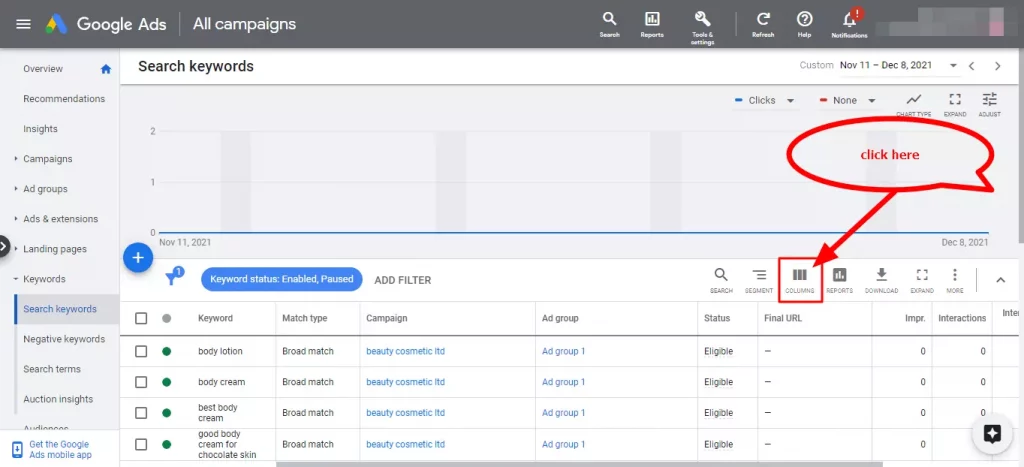
Click on quality score;
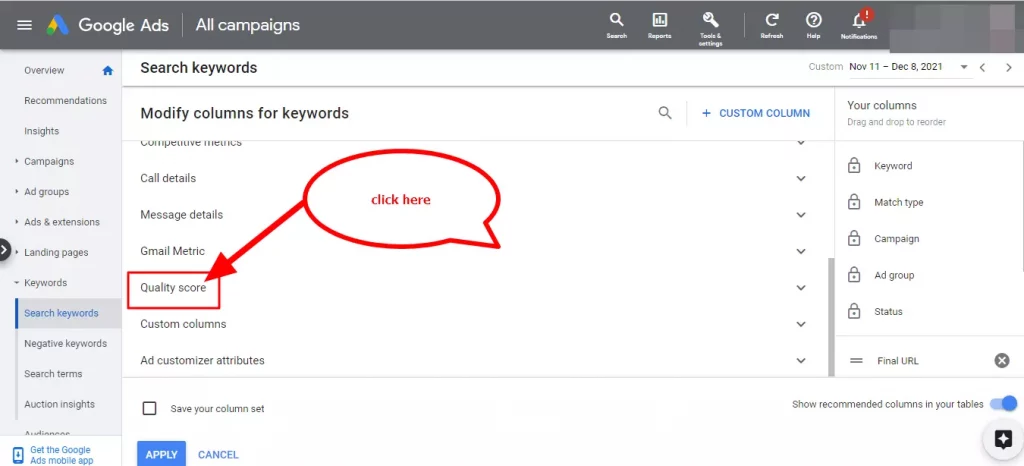
scroll down, you’ll see that quality score is an available option. So you’re gonna click on it, then, click apply.
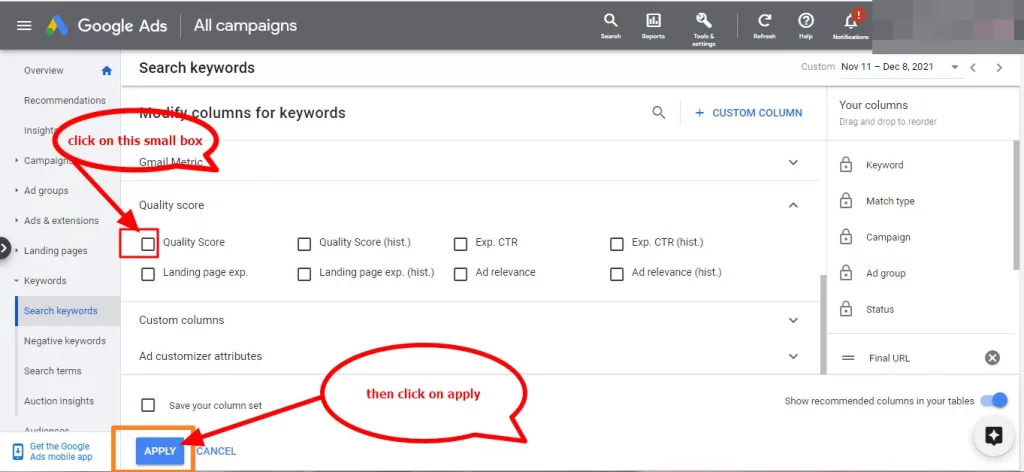
And now, you’ll see that quality score is now a column inside your dashboard.
Landing Page Quality Score Checker
You can actually check your landing page quality score the same way you would normally check your usual quality score.
There is no difference between a landing page quality score and the normal quality score that you know, as landing page experience is one of the factors that can help determine a quality score.
So, without the other 2 quality score components, you really cannot determine a quality score except you are planning to know the landing page experience.
If yes, then you have to follow the above procedures stated for quality score(the steps showcasing how to add quality score column).
But the difference this time is you won’t be adding a quality score column but rather, you would be adding the landing page experience column
Landing Page Experience Google Ads
Landing page experience in google ads simply means how relevant your landing page must have been when a user landed on the page.
If you sell televisions but were running an Ad for Samsung TVs, you definitely want to make sure that your landing page only has Samsung Tvs on it.
Adding other brands other than Samsung will only make your visitors bounce off your landing page as they weren’t getting enough information on the product that forced them to click in the first place. So, you really want to prevent such issues from arising.
Quality Score In Digital Marketing
When you hear quality score in digital marketing, just know they are referring to quality score in PPC as PPC is under digital marketing.
In a nutshell, quality score in digital marketing is a factor that contributes in or determines the CPC or ad position of an Ad
Google Ads Quality Score Column
By default, the google ads quality score column isn’t added; so you have to manually add it.
You can do so by locating the keyword tab in your ad account. Click on it then you will be taken to the keyword dashboard, locate the columns icon, click on columns, click on quality score, scroll down, then tick the quality score box and click on apply.
Google Ads Quality Score Overtime
To see past Quality Score stats for the reporting period you’re looking at, choose any of the following metrics:
- Quality Score (hist.)
- Landing Page Exper. (hist.)
- Ad Relevance (hist.)
- Exp. CTR. (hist.) You can see the change in daily scores by segmenting your table by day.
View the image below.
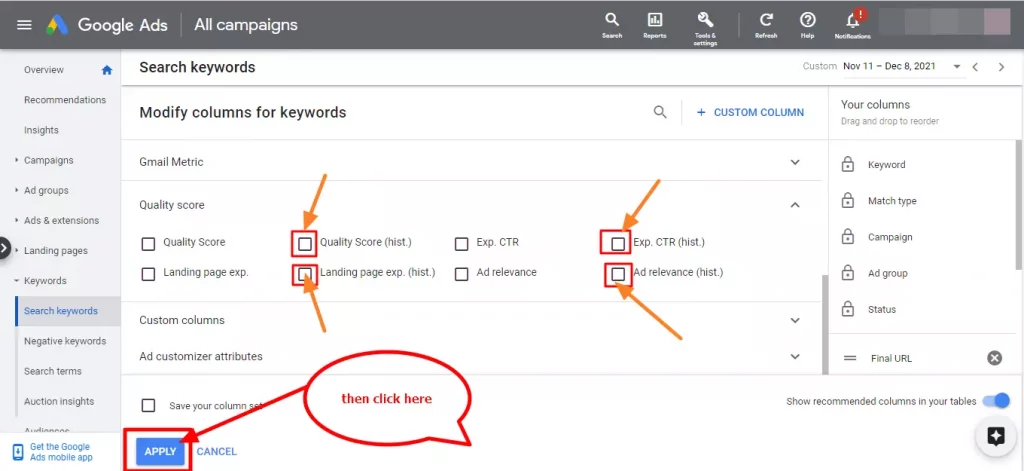
What Is Good Quality Score For Google?
A good quality score for google ads ranges from 7-10
How To Increase Quality Score Google Ads
To increase the quality score of your google ads, you have to work on the three components of quality score.
Quality score google ads formula
In the measurement of google ad quality score, we have three criteria we are gonna be looking at. And they are:
- Below average
- Average
- Above average
These three statuses are taken into consideration while calculating a quality score; Plus we have a standby basic quality score = +1, which is also referred to as the lowest possible value.
We also have the important factors we are looking at when calculating quality score and they are:
- Expected click through rate(is this below average?)
- Ads relevance (is this above average?)
- Landing page experience (is this average?)
Let’s say for example if:
KEYWORD= The best hair extensions
Expected click-through rate for THE BEST HAIR EXTENSIONS = 0, Status(below average)
Ad Relevance for THE BEST HAIR EXTENSIONS= 1, Status(average)
Landing page experience for THE BEST HAIR EXTENSIONS= 3.5, Status (above average)
Basic quality score for THE BEST HAIR EXTENSIONS= 1 (standby point)
NOTE: ECTRS= Expected click through rate status
ARS= Ad relevance status
LPES= Landing page experience status
BQS= Basic quality score (stand by point =1)
Therefore, the formula for google ads quality score is: ECTRS + ARS + LPES + BQS= QUALITY SCORE
Quality score = 0+2+3.5
Quality score = 5.5, approximately 6
Also note that anything:
- Below 1 is regarded as BELOW AVERAGE
- Equal to 1 is regarded as AVERAGE
- Equal and greater than 2 is regarded as ABOVE AVERAGE
What Are The Benefits Of Optimization Score?
1. It gives the best recommendation in order to guide you through the right part.
2. it helps in discovering some campaign problems therefore, giving you a heads up that something is wrong
3. It gives authentic estimates of Ads’ Progress
4. It provides you with a holistic view to understand the effect of Changes
5. It Saves Time
Which Of The Following Factors Wouldn’t Change An Accounts Optimization Score?
- Changes in auction dynamics
- Changes in tracked conversions
- Shifts in spend mix
- Renaming campaigns
Renaming campaigns is the only factor amongst all that wouldn’t change an accounts optimization score.
Therefore the correct answer is renaming campaigns.
Optimization Score Is Made Up Of
Optimization score is made up of over 50 recommendations, meant to help you optimize your search campaigns.
How Do You See Optimization Score Improving Your Advertising?
There’s a huge chance of it improving advertising as it increases the chances of your Ad doing better on the google search engines.
Optimization score has a lot of positive impact on the success of your advertising; why? Because it gives about 50 recommendations that give insights on how you can make your Ads better.
Should You Adhere To All Of The Ad Quality Score Recommendations?
I don’t think so as some of the suggestions seem to be off. Why would they be recommending something that wouldn’t even favor my business?
How Does Google Ads Generate Responsive Search Ads?
Google Ads generate responsive search ads by mixes and matches, headlines and description lines that have been provided.
What Is Google Ads Optimization?
Google ads optimization is the act of preparing or tweaking your ads to perform well in the google search engines.
How Are Optimization Score Suggestions Ordered On Your Google Ads Recommendations Page?
This actually depends on where you are lagging behind as a ppc person or where your campaign is lagging behind.
With you having an optimization score of 70%, it’s pretty obvious that order of recommendations will vary from that of your friend or competitor who has an optimization score of 95%.
Optimization score suggestions are ordered based on performance uplift, with the most impactful suggestions at the top of your Google Ads Recommendations page.
This makes sure that the most important suggestions are at the top and you can include these recommendations in your account.
However, Optimization score suggestions are ordered by the most impactful optimization in your google ads recommendation page.
When given an option like the one below, just go for by the most impactful optimization as it’s the right answer.
A) By least impactful optimization
(B) By most impactful optimization
(C) Alphabetically
(D) Randomly
Google ads optimization score recommendation consists of 5 categories and they are:
1– Repairs
2– Bidding & Budgets
3– Keywords & Targeting
4– Ads & Extensions
5– Automated campaigns
You can read a more detailed post about google ad recommendation here
Optimization Score Is Made Up Of Over 50 Recommendations To Optimize Search Campaigns True Or False?
The answer is TRUE
Google Ads Optimization Checklist
Below are the amazing google ads optimization checklist
1. Write persuasive ad copy
If you don’t optimize your ad copy, you’ll have a hard time generating site visitors from advertising. Here are some suggestions for improving ad copy:
1. Captivating Headline – The headline is the catchy phrase that draws people in. Make it impossible to resist.
2. Clever Ad Text – You only have a certain number of words to work with, so make the most of them. You may say more with fewer words when you use breviloquent sentences. When it comes to delivering value to users, focus on advantages rather than features.
3. Call-to-Action (CTA) — A strong call-to-action (CTA) generates a reaction. A discount or a limited offer might help to create a sense of urgency, which can lead to additional clicks.
4. Ad Extensions — Use extensions like snippets, site link extensions, and call extensions to boost the visibility of your ad copy. This has the potential to increase click through rates (CTR).
2. Make Your Landing Page Better
Someone who clicks on your ad will be taken to a landing page. Here are some campaign optimization suggestions to avoid losing prospects on your landing page:
1. Strong Headlines — When a user arrives, the headline is the first thing they will notice. It must be concise and captivating, as well as relevant to both your offer and the visitor.
2. Responsiveness – Make sure your landing pages are mobile-responsive to provide a consistent user experience across all platforms.
3. Loading Speed – Online users are impatient. They’ll depart if your site takes too long to load! To keep your bounce rate low, keep your material to a bare minimum and optimize your photos.
4. Material Relevance – As users spend more time on your site, your Ad Rank and Quality Score will improve as a result of more relevant content.
5. Updates – Constant updates are essential for campaign improvement. Maintain brand consistency by making sure your landing page information isn’t outdated.
3. Audience Segmentation
Before you can develop a long-term business, you must first understand your target market. Here’s how you can increase campaign optimization by better targeting your audience:
1. Create personas for your ideal customer so you know who you’re aiming for. This will help you choose keywords and write content.
Consider the pain points of your prospects. Consider their desires and create marketing, content, and products that address those issues.
2. Demographic Targeting — Depending on your campaign type, Google Ads allows you to target people within a specified age range, gender, or household income. You can save money by presenting your adverts to a more targeted audience.
3. Device Targeting – The devices you should employ for PPC advertising may be determined by your audience, products, or campaign.
A call-only campaign, for example, should solely target mobile device users. Take these aspects into consideration and alter your device bids accordingly.
4. Time Targeting – Try to time your adverts to coincide with when your target demographic is most engaged. Bids can be adjusted to favor specific days or times.
5. Geographical Targeting – This is useful for expanding local business. Set specified regions for your ad to appear, and exclude spots that aren’t doing well.
4. Search Engine Optimization
PPC campaigns are built on the foundation of keywords. By fine-tuning your keyword list, you can improve the performance of your adverts.
1. Keyword Discovery — To find high-value keywords that are related to your products and services, use Google Search Console and tools like Google keyword planner.
2. Relevance – When it comes to keywords, strike a balance between relevance and reach. You want to attract traffic, but it has to be qualified traffic in order to convert.
3. Increase bids on the most profitable keywords – Adjust your bids based on CTR and conversion rates for your keywords. Bids on low-performing terms should be reduced, while bids on high-performing terms should be increased.
4. Use Negative Keywords – Negative keywords help you save money by filtering out irrelevant traffic. Consider historical performance when adding relevant terms to your negative keyword list to guarantee you don’t miss out on good quality traffic.
5. Refine Match Types — When employing match types, consider your PPC objectives. Modified Broad is great for brand exposure, whereas Exact Match is best for specialized targeting and conversions.
5. Discovery
Data analysis and campaign optimization are inextricably linked. Here are a few pointers to help you get the most of your monitoring and analysis:
1. Test & Analyze Frequently — When it comes to paid advertising, you must always be testing something! You can uncover problems, discover possibilities, and improve your campaigns for greater ROAS by testing and analyzing them on a regular basis.
2. Experiment with New Ad Copy – Don’t limit yourself to just one ad copy for your commercials. To discover the most effective version, split-test different variants and analyze the results.
3. Think about the competition – Markets and consumer preferences are constantly changing, and you must be prepared to adapt.
Keep an eye on your competitors’ activities and use their campaigns to learn from them.
By examining successful competitors, you can discover profitable keywords, brilliant ad text ideas, and savvy bidding techniques.
You Want To Create A Click To Call Campaign Which Campaign Goal Should You Start With?
You should start with the LEADS OR SALES GOAL
Conclusion
Knowing how important quality score is for Ads performance and other factors affecting ads, advertisers should pay attention to quality score most especially if they want to spend little on google ads.

